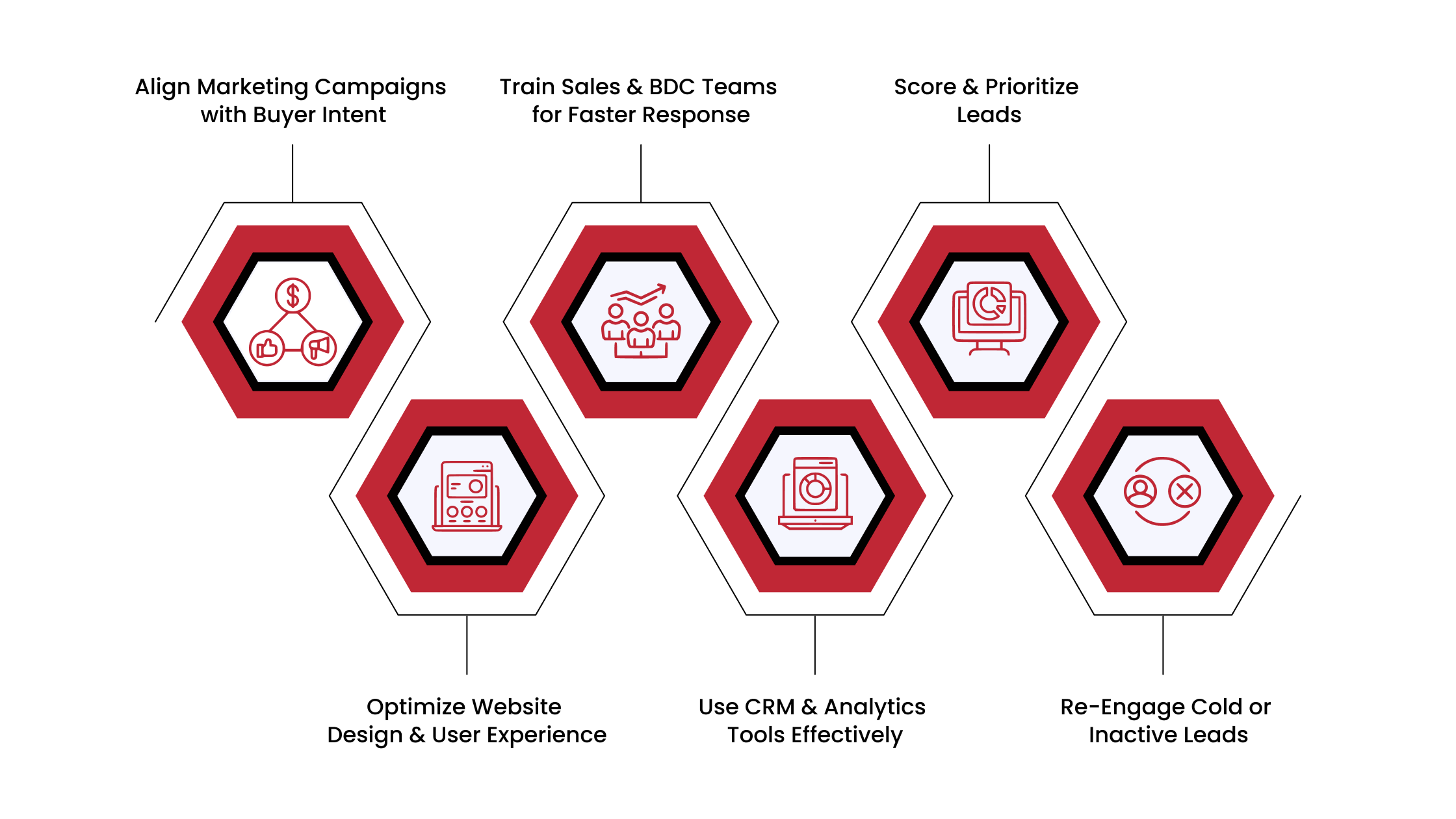How to Improve Dealership Lead Quality to Increase Sales?

Car dealerships don’t struggle to get leads, but they struggle to get the right ones. Sales teams often find themselves chasing long lists of prospects who have little intent, no budget, or aren’t even in the market to buy. This drains the valuable time and increases the cost of acquisition for every car sold.
A report found that 61% of marketers consider generating high-quality leads their biggest challenge. That frustration is amplified in the automotive space, where aggressive ad spending often produces volume but not conversions.
Improving dealership lead quality isn’t just about filling the CRM with names. It’s about ensuring your sales team engages with people who are actually ready to make a purchase. Addressing this issue can shorten the sales cycle, reduce wasted marketing spend, and, most importantly, help your dealership increase revenue without overextending its resources.
What Makes a Lead “High Quality”?
Dealerships often waste time chasing leads that never move past the initial interest stage. A high-quality lead, on the other hand, shows clear buying signals, aligns with your dealership’s target audience, and has the potential to move quickly through the sales funnel. Understanding these traits is the first step toward improving dealership lead quality.
- Strong Purchase Intent: Leads actively searching for a vehicle, not just browsing.
- Budget Alignment: Prospects with financial capacity that matches the cars you sell.
- Timely Need: Customers are ready to decide on the near term rather than months away.
- Accurate Contact Information: Complete, valid details that enable meaningful follow-ups.
- Engagement History: Prior interactions with your website, emails, or sales team that suggest genuine interest.
Focusing on these characteristics ensures that your dealership invests effort into leads that are most likely to turn into profitable sales.
Primary Metrics to Measure Lead Quality

Improving dealership lead quality calls for measurable indicators that reveal how close a lead is to becoming a buyer. Dealers who consistently track performance data gain the clarity needed to refine marketing strategies and allocate sales resources more effectively.
Lead Conversion Rate
This metric indicates the percentage of leads that actually convert into paying customers. A higher conversion rate typically means that your dealership is attracting leads that align with your inventory and purchasing process.
Cost per Lead (CPL)
Measuring CPL helps you understand if your marketing dollars are generating valuable leads or if resources are being wasted on channels that don’t produce qualified prospects.
Lead Response Time
The speed at which your team responds to inquiries often determines if the customer stays engaged. Faster response times typically lead to better conversion rates and stronger dealership lead quality.
Lead Source Effectiveness
By analyzing which channels, social ads, website forms, referrals, or third-party listings produce higher-quality leads, you can prioritize the most profitable ones.
Engagement Level
Tracking behaviors, such as email opens, website visits, or interactions with your digital showroom, provides a clear signal of how serious a lead is about making a purchase.
When dealerships consistently measure these metrics, they gain the insight needed to improve lead targeting, streamline sales efforts, and ultimately close more deals.
Top 6 Strategies to Improve Dealership Lead Quality

Improving dealership lead quality requires a deliberate approach to attracting, nurturing, and converting the right prospects. Dealers who implement structured strategies can filter out weak leads and focus resources on customers with genuine buying intent. Here are proven ways to elevate the quality of your leads.
1. Align Marketing Campaigns with Buyer Intent
One of the fastest ways to improve dealership lead quality is by ensuring your marketing aligns with what customers are actively searching for. Instead of broad campaigns that capture anyone’s attention, targeted ads and SEO strategies focus on people researching specific models, financing options, or trade-in values.
By utilizing buyer personas, keyword data, and intent-based targeting, dealerships can decrease unqualified inquiries and enhance engagement with ready-to-buy customers. This ensures the leads reaching your team already have a higher probability of moving further down the sales funnel.
2. Optimize Website Design & User Experience
A dealership’s website often serves as the first impression for potential buyers, making user experience a decisive factor in lead quality. A clean design with fast-loading pages, intuitive navigation, and clear calls to action builds trust and encourages serious shoppers to engage.
Integrating live chat, transparent pricing tools, and instant trade-in calculators gives buyers the confidence to share their information with ease. When leads find it easy to access details about vehicles, financing, and scheduling test drives, they’re more likely to be qualified.
A frictionless digital experience filters casual browsers out and captures the interest of genuine buyers ready to connect with your sales team.
3. Train Sales & BDC Teams for Faster Response
Lead quality improves significantly when dealership staff respond promptly and professionally. Research shows that customers contacted within the first hour of inquiry are far more likely to convert into paying buyers. Training sales and BDC teams to follow a structured outreach process ensures that leads receive timely communication, which builds trust. Scripts, CRM reminders, and performance monitoring can help teams stay consistent.
Beyond speed, quality follow-up also matters, like listening to customer needs, offering relevant solutions, and personalizing communication, all of which help nurture higher-quality leads. This is where Automotive Training Network (ATN) makes a measurable difference.
Our tailored training programs equip dealership teams with proven communication frameworks, real-world role-playing exercises, and ongoing performance reviews to enhance their effectiveness. By focusing on both responsiveness and relationship-building, ATN helps dealers turn initial inquiries into strong, high-quality leads that directly impact sales performance.
4. Use CRM & Analytics Tools Effectively
CRM and analytics systems are powerful tools for enhancing dealership lead quality, as they offer visibility into the origin of leads and their progression. By tracking customer interactions, dealers can identify patterns that distinguish high-quality leads, such as repeated website visits, financing inquiries, or a history of service.
Analytics dashboards also help compare lead sources, calculate ROI, and fine-tune campaigns. Instead of relying on guesswork, dealerships using these tools can allocate resources toward the most profitable channels. The result is a streamlined pipeline that consistently delivers leads with a higher likelihood of purchasing, making sales efforts more efficient and effective.
Automotive Training Network (ATN) strengthens this approach through its Dealership Management Program, which provides:
- Customized CRM templates and workflows tailored to dealership operations.
- Monthly sessions with managers to review lead performance against set objectives.
- Frequent advertising spend reviews to connect marketing investments with measurable returns.
- Advanced reporting and equity mining strategies that uncover hidden sales opportunities.
- Continuous coaching and process refinement to ensure CRM data translates into actionable improvements.
With this structured support, dealerships not only track their leads more effectively but also refine their approach to nurturing and converting them into profitable sales.
5. Score & Prioritize Leads
AI-powered lead scoring methods analyze customer data, including browsing behavior, engagement with dealership websites, responses to marketing campaigns, and purchase history, to assign a quality score. High-scoring leads indicate stronger purchase intent, enabling sales teams to focus their energy where it matters most.
This process reduces wasted time on low-probability prospects while ensuring valuable opportunities get fast, personalized attention. By prioritizing leads, dealerships improve sales efficiency, shorten the buying cycle, and enhance the overall customer experience.
A structured scoring system ensures that marketing and sales teams are always aligned on what “high quality” truly means.
6. Re-Engage Cold or Inactive Leads
Leads that go cold are often left untouched, yet many of them still hold strong buying potential. A dealership that re-engages these prospects through tailored campaigns can uncover valuable opportunities. Techniques such as personalized email sequences, seasonal offers, or targeted social ads can reignite interest and bring inactive customers back into the funnel.
This is where ATN’s sales training makes a difference. Their programs teach teams how to craft effective re-engagement strategies that feel authentic rather than pushy. With structured follow-up scripts, role-play coaching, and advanced CRM workflows, staff learn how to re-approach prospects with confidence.
ATN emphasizes timing, tone, and personalization, helping dealerships reconnect with dormant leads and convert them into active buyers.
Common Pitfalls That Reduce Lead Quality (and How to Avoid Them)
Even well-run dealerships can unintentionally weaken their lead quality. Recognizing these issues and building strategies to counter them ensures stronger sales outcomes.
- Slow Response Times: Delaying follow-up allows competitors to engage first. Establishing structured response processes and using CRM alerts ensures leads are contacted promptly, ideally within the first hour.
- Poor Lead Source Management: Over-reliance on low-performing channels often floods the pipeline with unqualified prospects. Regularly tracking source performance and shifting budget toward channels with higher conversion rates creates a healthier flow of quality leads.
- Generic Messaging: Prospects rarely respond well to one-size-fits-all outreach. Tailoring communication to customer behavior, preferences, and past interactions helps build trust and makes each touchpoint more impactful.
- Neglecting Lead Nurture: Many dealerships focus only on “ready-to-buy” customers while warm prospects slip away. Implementing nurture campaigns keeps your brand top of mind and maintains engagement until buyers are ready to purchase.
- Weak Data Practices: Outdated or inaccurate customer records reduce the effectiveness of follow-ups and frustrate staff. Consistently cleaning and validating CRM data ensures sales teams work with reliable information.
Addressing these pitfalls through structured processes, smarter data utilization, and customer-centered communication helps dealerships maintain strong and full pipelines of high-quality prospects.
Build a High-Quality Sales Pipeline with ATN Expertise

Improving dealership lead quality requires consistent training, structured processes, and expert guidance. Automotive Training Network (ATN) helps dealerships turn raw inquiries into qualified buyers through proven strategies and hands-on support.
When you partner with ATN, you gain access to:
- Sales and BDC training that sharpens response time and follow-up quality
- CRM and lead management expertise to streamline workflows and track performance
- Customized dealership management programs covering sales, service, and digital marketing
- Regular coaching sessions to ensure strategies turn into measurable results
- Comprehensive reviews of lead quality metrics to improve conversions over time
Strengthen your dealership lead quality and start converting more prospects into loyal customers.
